|
|
|
|
|
|
|
Achi-Kochi Japan
Showing many places to visit and foods to eat in Japan
|
|
|
|
|
|
|
|
|
|
|
|
|
Japan
> Hokuriku region
> Gokayama
|
|
|
|
|
|
|
Gokayama
Toyama Pref., Hokuriku ( Achi-Kochi Japan )
|
|
|
|
|
|
|
|
|
|
|
|
|
( "Achi-Kochi" in Japanese means "Here and there" in English. )
Gokayama, Toyama Pref., Hokuriku Region

In Gokayama area ( above ), Nanto City, located in the southwest of Toyama Prefecture, in the east of Hokuriku Region, there are two villages which are a part of UNESCO World Cultural Heritage Site " Historic Villages of Shirakawa-go and Gokayama ".
In the two villages ( Suganuma and Ainokura ), there remain unique and traditional Gassho Style Houses ( or Gassho Zukuri Houses ) as well as in Shirakawa-go, which is located to the south of Gokayama area.
|
|
Suganuma Village
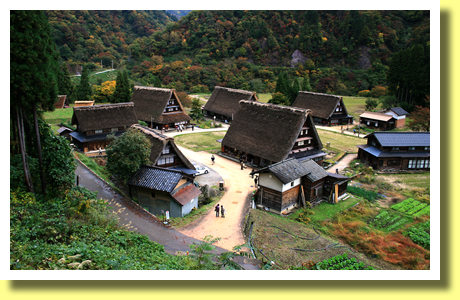
In Suganuma ( above ), a village located in Gokayama area, remain nine Gassho Style Houses, most of which were built a few hundreds years ago. "Gassho" in Japanese means "pressing one's hands together, with palms touching, in prayer". Triangular frame of a thatched roof resembles "Gassho". Such buildings are called "Gassho Style Houses" ( or Gassho Zukuri Houses ).
Gokayama area including Suganuma Village is surrounded by mountains and its snowfall is so heavy. In such environment, the design of Gassho Style Houses evolved in the 18th-19th centuries. So Gassho Style Houses can be seen only in Gokayama and Shirakawa-go.
|
|
Gassho Style Houses
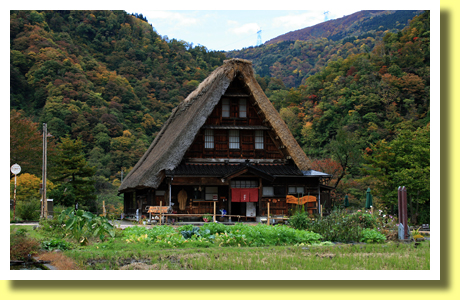
Some of Gassho Style Houses in Suganuma Village are used as souvenir shops, a guest house and restaurants such as Gorobei ( above ), where tourists could enjoy eating local specialty dishes in a Gassho Style House.
|
|
Inside Gassho Style Houses
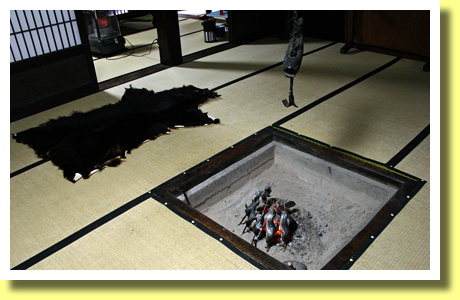
Inside Gassho Style House of Gorobei, there is irori ( a Japanese fireplace ) in the floor and iwana ( rock fishes ) could be grilled around charcoal fire as above.
|
|
Local Specialties

Restaurant Gorobei offers local specialties such as Gokayama Tofu ( bean curd ), buckwheat noodles, chargrilled rock fish and so on ( above ).
|
|
Nitre Museum
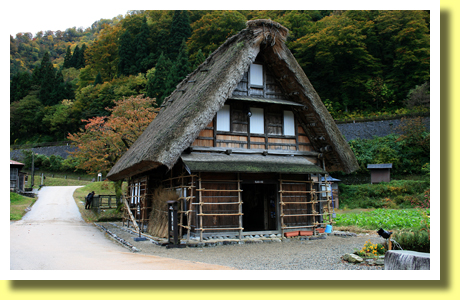
During Tokugawa Period, production of nitre ( saltpeter - an ingredient of gunpowder ) was one of the important industries in Gokayama. One of Gassho Style Houses in Suganuma Village is used as Nitre Museum ( above ) displaying history, tools and process of nitre production.
There had not been plenty of paddy fields in Gokayama area to pay taxes to Kaga Feudal Domain during Tokugawa Period. So other industries such as nitre production, silkworm raising and paper making were important in the area.
|
|
Folklore Museum
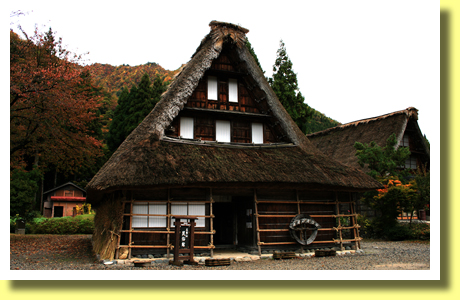
Another one of Gassho Style Houses is used as Folklore Museum ( above ), which display 200 items showing how people had live in a mountain village. Also tourists could go upstairs to see the structures of the house as well as tools used for silkworm raising which had been one of important industries in the area.
|
|
Souvenir Shop
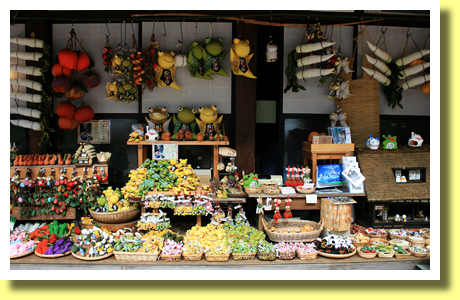
One of Gassho Style Houses in Suganuma Village is used as a souvenir shop, which displays unique souvenirs ( above ). It could be fun to visit the shop.
|
|
Ainokura Village
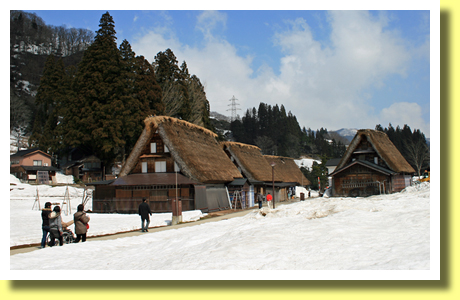
Ainokura Village ( above ) is a part of UNESCO World Cultural Heritage Site " Historic Villages of Shirakawa-go and Gokayama " as well as Suganuma Village and Shirakawa-go are. In Ainokura Village remain 20 Gassho Style Houses, some of which are a few hundreds years old and some of which are used as guesthouses.
|
|
Inside Murakami Residence

The Murakami Residence is open to the public and tourists could walk inside the residence ( above ).
|
|
Upstairs Murakami Residence

Tourists could walk upstairs to the 2nd ( above ) and 3rd floors of the Murakami Residence where a few thousands tools are exhibited to show nitre production and papermaking.
In Gassho Style Houses, the 1st floor was used for residence and papermaking while space underneath was for nitre production and upper floors were for silkworm raising.
|
|
Rukei-goya

There is Rukei-goya ( above ) near the Murakami Residence. "Rukei" in Japanese means "exile" while "goya" does "hut". So "Rukei-goya" means "exile hut".
During Tokugawa Period, feudal lords of Kaga Feudal Domain exiled some political offenders to Gokayama and they were confined in the exile huts. The original hut was destroyed in A.D.1963 by heavy snowfall and the reconstruction was completed in A.D.1965 as it had been.
|
|
Shirakawa-go
Gokayama is a part of UNESCO World Cultural Heritage Site " Historic Villages of Shirakawa-go and Gokayama " together with Shirakawa-go, which is located in the north of Gifu Perfecture, in the northwest of Tokai Region.
|
Copyright (c) 2021 Achi-Kochi Zanmai Co., Ltd.
|